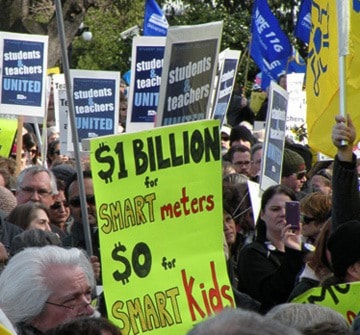VICTORIA – Another school year dawns in B.C., with the prospect of disruptive labour disputes.
First up are 27,000 support staff, in a legal strike position. These are the teacher aides, custodians, bus drivers and crossing guards. Most are members of the Canadian Union of Public Employees, with a few Teamsters and other locals scattered around the 60 school districts.
Public discussion about these disputes usually focuses on wage increases, which CUPE members in schools haven’t seen for four years. Their current deals expired more than a year ago, after they were subject to the same two-year wage freeze imposed on the rest of government.
The B.C. government moved from the post-recession wage freeze to a system they call “co-operative gains,” where raises must be financed by savings in other areas of the operation. Only two provincial employee groups have yet to do this: school support staff and teachers.
(Education Minister Peter Fassbender confirmed last week that teacher raises will be funded by extra transfers from the provincial treasury as they try to get a long-term deal. But that’s a topic for another day.)
CUPE, the largest union in the country, has a sophisticated media campaign to generate public sympathy. We are repeatedly reminded not only that the last raise was 2009, but that the “average” pay is a mere $24,000 a year. If that number is accurate, it reflects a large number of part-timers.
Let’s look at a few provisions CUPE doesn’t talk about, on behalf of those self-employed taxpayers who have no paid holidays, no employer pension or benefits and no paid overtime, but are expected to help pay all of the above to government workers.
The 60 contracts have many variations, but core elements are the same. In the Central Okanagan school district, the starting CUPE wage rate is $17.37 an hour. The top rate is $26.59, or $28.78 for workers who qualify for a “trades adjustment.”
All contracts have rigid seniority and “bumping” clauses to ensure that new employees absorb any reductions in working hours. From a taxpayer’s perspective, this leads to the maximum number of employees making the highest wages.
Overtime in Central Okanagan is time and a half for the first two hours, and double time after that. Contracts also include the provision that unscheduled overtime is subject to a four-hour minimum. It’s amazing how often an unexpected hour of work can arise when it’s paid at quadruple time.
The Surrey school district contract details how even “spare board” employees are to be enrolled in the municipal pension plan, a defined-benefit system most private-sector employees can only dream about.
Then there are paid sick days. The Canadian Taxpayers’ Federation reports that the average B.C. private sector worker took 7.4 sick days last year. The public sector average was 12.
The Surrey contract details the windfall of unused sick days that must be paid out to employees who retire as early as age 55. The maximum is 150 days, for a lavish perk only available to employees hired before July 1, 1996. Even so, we’ll be paying these bonuses out for years to come.
It goes on and on. Six weeks’ paid vacation after 20 years, with an extra day added for every year after that.
There are many little things, such as a $60 “swimsuit allowance” for teacher aides who take part in swimming instruction.
This is not to devalue the work done by these people. It is to suggest that given the growing gap between public and private employment benefits, finding savings is reasonable.
Tom Fletcher is legislative reporter and columnist for Black Press and BCLocalNews.com. Twitter:@tomfletcherbc
